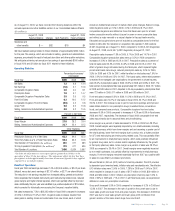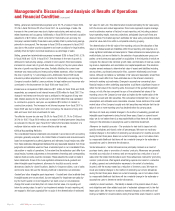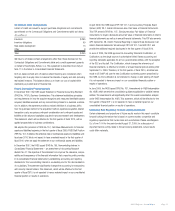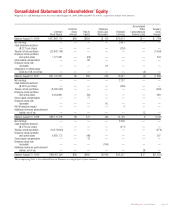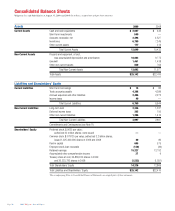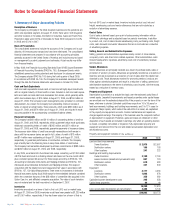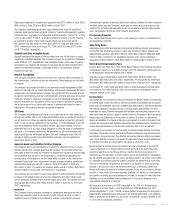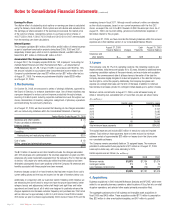Walgreens 2009 Annual Report Download - page 24
Download and view the complete annual report
Please find page 24 of the 2009 Walgreens annual report below. You can navigate through the pages in the report by either clicking on the pages listed below, or by using the keyword search tool below to find specific information within the annual report.
These proceeds were used to pay down borrowings under our commercial paper
program and purchase short-term Treasury Bills. Short-term borrowings paid dur-
ing the current fiscal year were $70 million as compared to $802 million in the
previous year. Shares totaling $279 million were purchased to support the needs
of the employee stock plans during the current period as compared to $294 million
ayear ago. On January 10, 2007, a stock repurchase program (“2007 repurchase
program”) of up to $1,000 million was announced, to be executed over four years.
No repurchases were made during the current or prior year under this plan.
On October 14, 2009, our Board of Directors approved a long-term capital policy.
Our long-term capital policy is to: maintain a strong balance sheet and financial
flexibility; reinvest in our core strategies; invest in strategic opportunities that rein-
force our core strategies and meet return requirements; and return surplus cash
flow to shareholders in the form of dividends and share repurchases over the
long term. In connection with our capital policy, our Board of Directors authorized a
new stock repurchase program (“2009 repurchase program”) and set a long-term
dividend payout ratio target between 30 and 35 percent. The 2009 repurchase
program, which replaced the 2007 repurchase program, allows for the repurchase
of up to $2,000 million of the Company’s common stock prior to its expiration on
December 31, 2013. In addition, we will continue to repurchase shares to support
the needs of the employee stock and option plans. We had proceeds related to
employee stock plans of $138 million during the current fiscal year as compared
to $210 million a year ago. Cash dividends paid were $446 million during the
current fiscal year versus $376 million a year ago.
Management’s Discussion and Analysis of Results of Operations
and Financial Condition (continued)
We had no commercial paper outstanding at August 31, 2009. In connection with
our commercial paper program, we maintain two unsecured backup syndicated
lines of credit that total $1,200 million. The first $600 million facility expires on
August 9, 2010, and allows for the issuance of up to $400 million in letters of
credit, which reduce the amount available for borrowing. The second $600 million
facility expires on August 12, 2012. Our ability to access these facilities is subject
to our compliance with the terms and conditions of the credit facility, including
financial covenants. The covenants require us to maintain certain financial ratios
related to minimum net worth and priority debt, along with limitations on the sale of
assets and purchases of investments. As of August 31, 2009, we were in compliance
with all such covenants. The Company pays a facility fee to the financing bank to
keep these lines of credit active. While we are still able to access these lines of
credit, as of August 31, 2009, there were no borrowings outstanding against these
credit facilities. We do not expect any borrowings under these facilities, together
with our outstanding commercial paper, to exceed $1,200 million.
Our current credit ratings are as follows:
Long-Term Commercial
Rating Agency Debt Rating Paper Rating Outlook
Moody’s A2 P-1 Stable
Standard & Poor’s A+ A-1 Negative
In assessing our credit strength, both Moody’s and Standard & Poor’s consider
our business model, capital structure, financial policies and financial statements.
Our credit ratings impact our borrowing costs, access to capital markets and
operating lease costs.
Page 22 2009 Walgreens Annual Report
Contractual Obligations and Commitments
The following table lists our contractual obligations and commitments at August 31, 2009 (In millions):
Payments Due by Period
Total Less Than 1 Year 1–3 Years 3– 5 Years Over 5 Years
Operating leases (1) $34,582 $1,995 $4,121 $3,996 $24,470
Purchase obligations (2):
Open inventorypurchase orders 1,477 1,477 — — —
Real estate development 383 381 2 — —
Other corporate obligations 508 287 140 47 34
Long-term debt* 2,358 10 4 1,304 1,040
Interest payment on long-term debt 752 113 232 168 239
Insurance* 494 164 154 72 104
Retiree health* 328 11 24 29 264
Closed location obligations* 99 21 28 16 34
Capital lease obligations* 40 3 4 3 30
Other long-term liabilities reflected on the balance sheet* (3) 685 52 123 129 381
Total $41,706 $4,514 $4,832 $5,764 $26,596
* Recorded on balance sheet.
(1) Amounts for operating leases and capital leases do not include certain operating expenses under these leases such as common area maintenance,
insurance and real estate taxes. These expenses for the Company’s most recent fiscal year were $335 million.
(2) Purchase obligations include agreements to purchase goods or services that are enforceable and legally binding and that specify all significant terms,
including open purchase orders.
(3) Includes $58 million ($19 million due in 1–3 years, $30 million due in 3–5 years and $9 million due over 5 years) of unrecognized tax benefits
recorded under FIN 48, which we adopted on September 1, 2007.









